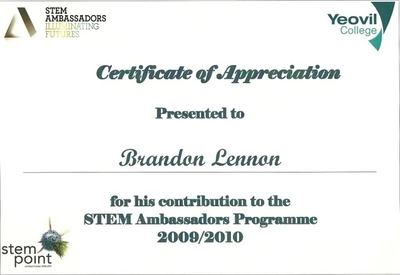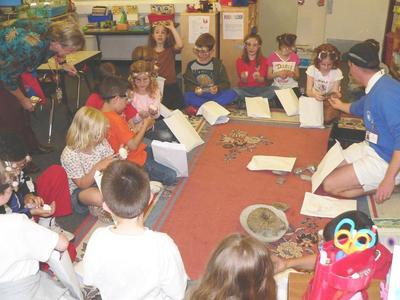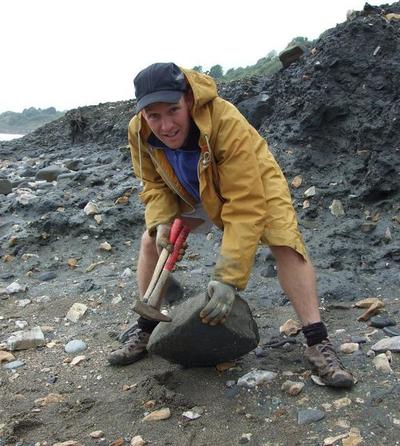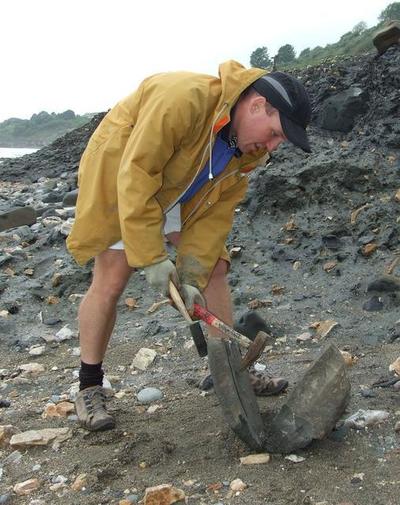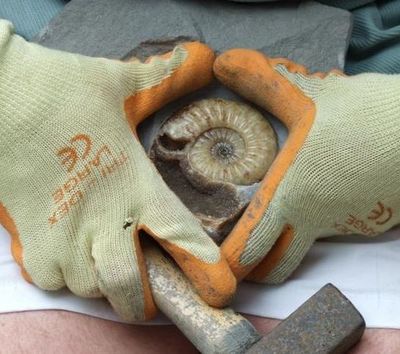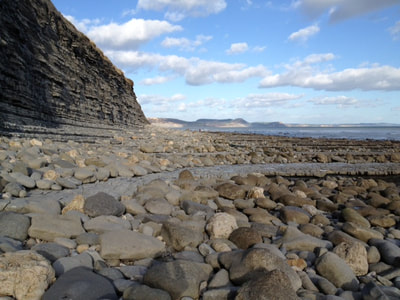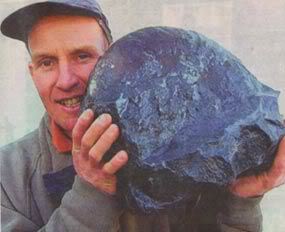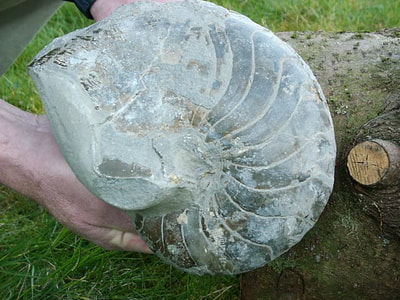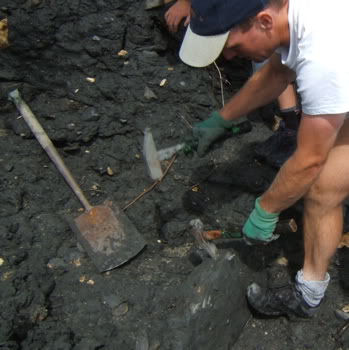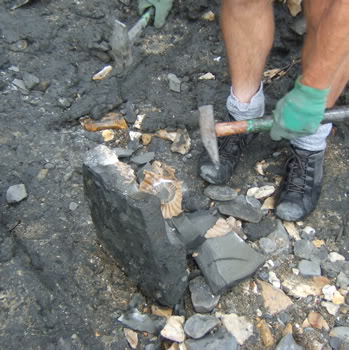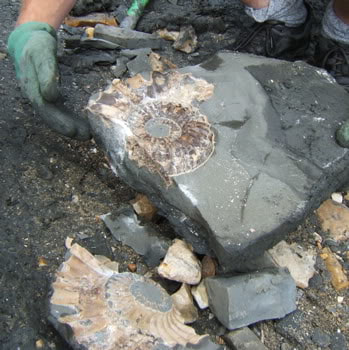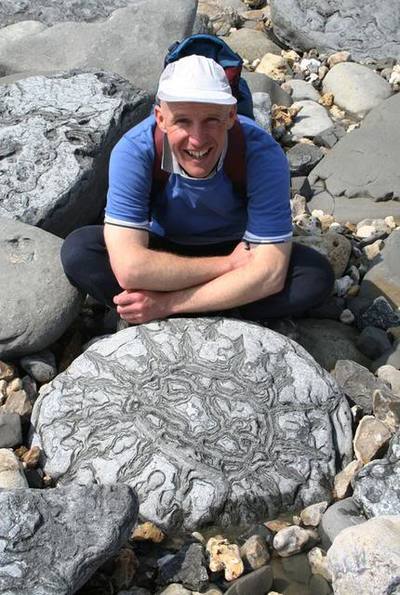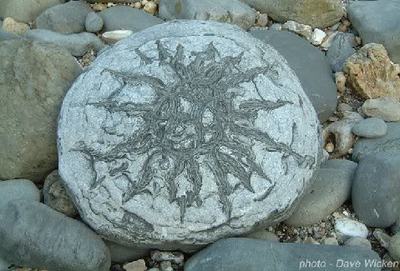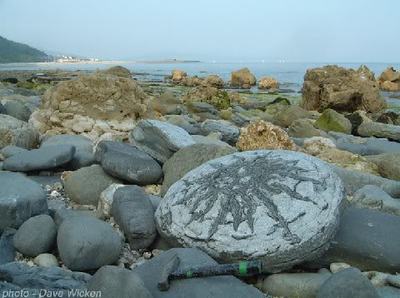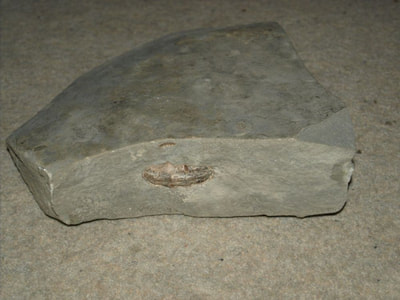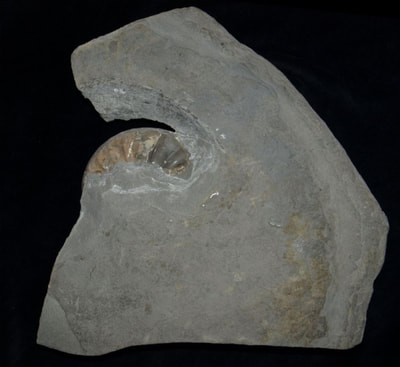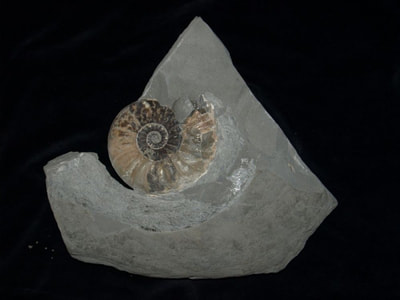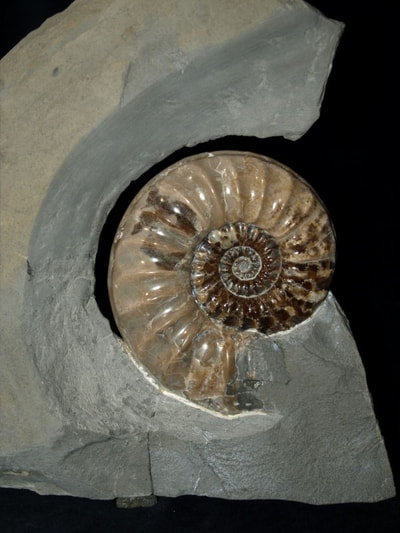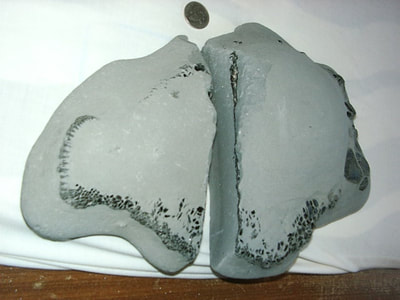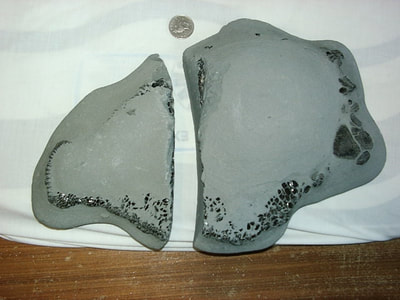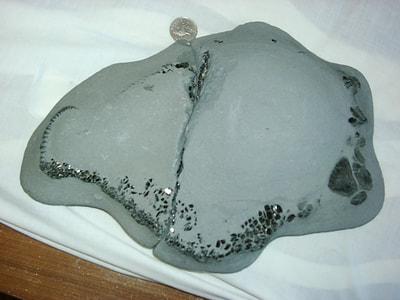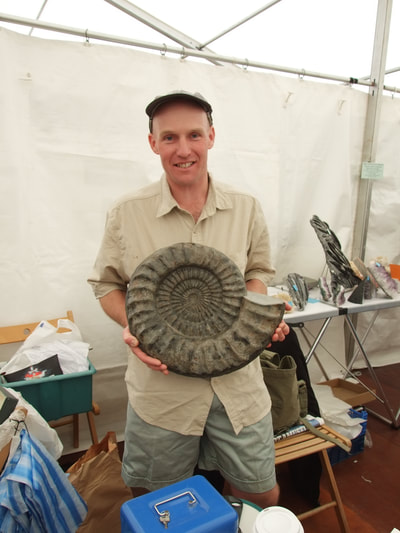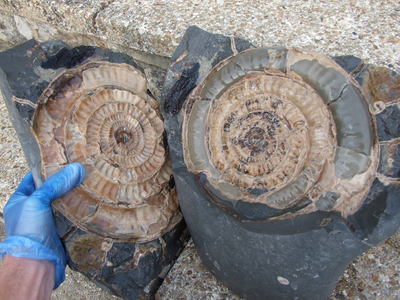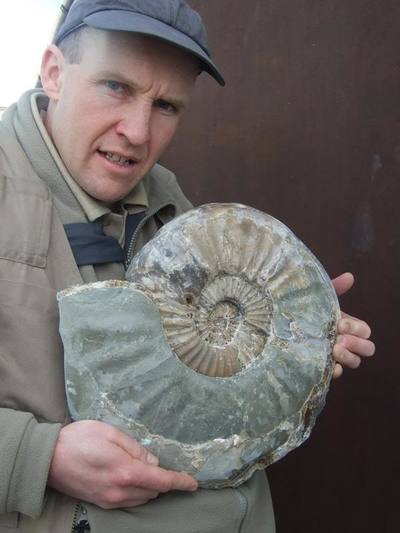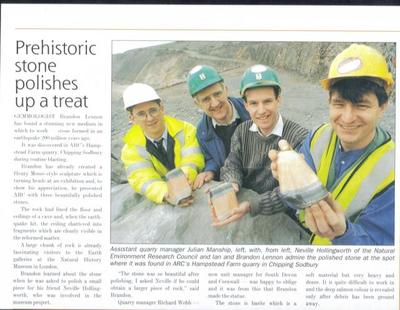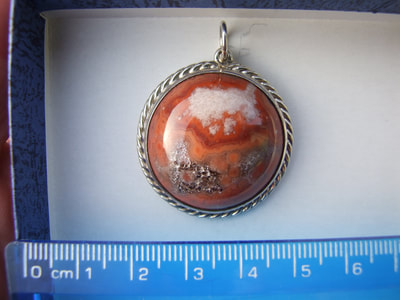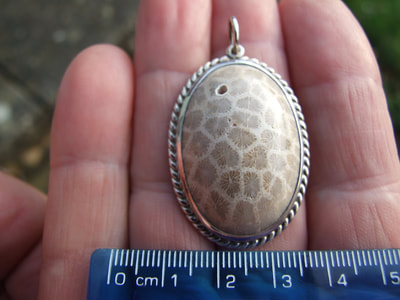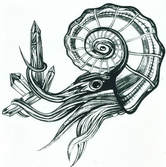See A Slide Show Of Lyme Regis Fossils Below
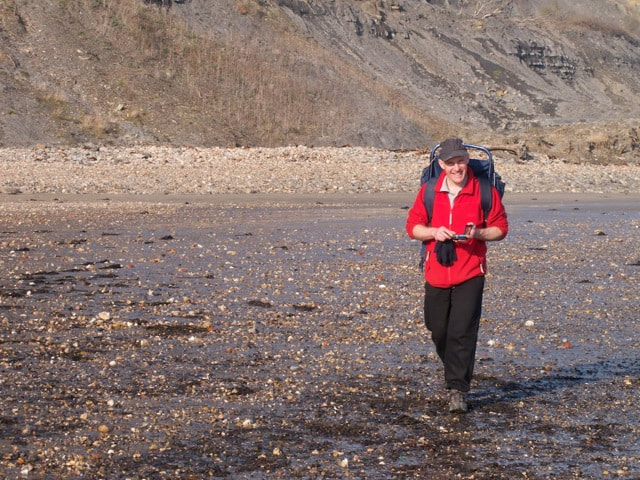
My name is Brandon Lennon ,I am a professional fossil collector from Lyme Regis,Dorset.I have taught in schools in Cambridge,London and the Dorset area as a STEM AMBASSADOR.I provide schools with practical lessons and talks on the science of geology.As well as selling fossils I also have taken fossil walks out along the Jurassic coast for 30 years.The person whom I admire is Mary Anning, the famous fossil hunter from Lyme Regis. I am a trustee of "Mary Anning Rocks", and i have been very delighted to help with the statue of Mary Anning in Lyme Regis. Mary Anning (1799 - 1847) was one of the greatest British fossil collectors who have ever lived. She was born in very humble circumstances in Lyme Regis, Dorset, and lived there all her life. At the age of only twelve she found the first recorded Ichthyosaur at Lyme Regis, and in later years found the first near complete Plesiosaur and first British specimen of a flying reptile, Dimorphodon.
Mary was a witness to the birth of the science of Palaeontology and, although she had virtually no schooling, she read all the scientific papers of the day and created perfect drawings of many of her finds.In some ways Mary Anning was responsible for educating the best brains of the country at that time. She became so famous that she could count among her acquaintances William Buckland, the first Professor of Geology at Oxford University, Sir Henry de la Beche, the founder of the British Geological Survey, and Professor Richard Owen, one of the founders of the Natural History Museum in London.Mary Anning is buried in Lyme Churchyard and her grave can be visited. The tongue twister “She Sells Sea Shells by the Seashore” is actually written about Mary, and the sea shells were fossil sea shells she found!"Many times during the night,the raging winter storm had awakened Mary."Where were those storms?In Lyme Regis, Dorset.This is how Helen Bush chose to open her beautifully crafted book about Mary Anning.The book is called, "Mary Anning`s Treasures".(Puffin Books 1976) We hope that, by joining our Fossil Walk, some of you may be inspired to follow in Mary’s footsteps.If you come on our fossil walk you may find one or two of the "curiosities," which is what Mary Anning called the fossils in the old days.
Our walks are mentioned in the Times Online,the Daily Telegraph,and the Guardian Newspaper.Brandon is featured in the 2015 Bradt Travel Guide with an article about his fossil collecting walks.Brandon is featured in the new Hideaways news article guide to the Jurassic Coast.
Mary was a witness to the birth of the science of Palaeontology and, although she had virtually no schooling, she read all the scientific papers of the day and created perfect drawings of many of her finds.In some ways Mary Anning was responsible for educating the best brains of the country at that time. She became so famous that she could count among her acquaintances William Buckland, the first Professor of Geology at Oxford University, Sir Henry de la Beche, the founder of the British Geological Survey, and Professor Richard Owen, one of the founders of the Natural History Museum in London.Mary Anning is buried in Lyme Churchyard and her grave can be visited. The tongue twister “She Sells Sea Shells by the Seashore” is actually written about Mary, and the sea shells were fossil sea shells she found!"Many times during the night,the raging winter storm had awakened Mary."Where were those storms?In Lyme Regis, Dorset.This is how Helen Bush chose to open her beautifully crafted book about Mary Anning.The book is called, "Mary Anning`s Treasures".(Puffin Books 1976) We hope that, by joining our Fossil Walk, some of you may be inspired to follow in Mary’s footsteps.If you come on our fossil walk you may find one or two of the "curiosities," which is what Mary Anning called the fossils in the old days.
Our walks are mentioned in the Times Online,the Daily Telegraph,and the Guardian Newspaper.Brandon is featured in the 2015 Bradt Travel Guide with an article about his fossil collecting walks.Brandon is featured in the new Hideaways news article guide to the Jurassic Coast.
Extreme Tides set to attract hunters
News article from Wed 15th Sept 2010, Briport and Lyme Regis News
Fossil enthusiasts have been heading for Lyme Regis and Charmouth in large numbers over recent days to take advantage of the extreme tides. They were alerted to the chance of some monster finds being exposed by the respected national website Everything Dinosaur. They predicted a fossil bonanza being uncovered by the lowest tides of the year along the Jurassic Coast. “This could lead to a number of exciting fossil finds as a combination of rough seas in the previous few days and low tides expose potential new discoveries,” said the site. “Fossil hunters are expected to flock to Lyme Regis and nearby Charmouth on the hunt for ammonites, belemnites and fossils of marine reptiles. Although the chances of finding a dinosaur are remote, the low tides will expose areas not normally explored and the recent pounding the cliffs have taken from the bad weather could reveal many new finds.”
Lyme Fossil Walks organiser Brandon Lennon was already reaping the benefits on Friday. Speaking on his mobile phone on the beach he said his party had found some interesting ammonites – including an Asteroceras. The Lyme Museum guided walk group just ahead of him had found some ichthyosaur vertebrae. Experts say joining organised parties is the safest way to hunt for fossils – the beaches and cliffs around Lyme Regis can be dangerous places. It is all too easy to get cut off and trapped by an incoming tide.Mr Lennon, who runs fossil hunting trips can be contacted on 07854 377 519 or via his website at Lyme Regis Fossil Walks. (Extract from Bridport and Lyme Regis
News, Feb 19th 2009.)
News article from Wed 15th Sept 2010, Briport and Lyme Regis News
Fossil enthusiasts have been heading for Lyme Regis and Charmouth in large numbers over recent days to take advantage of the extreme tides. They were alerted to the chance of some monster finds being exposed by the respected national website Everything Dinosaur. They predicted a fossil bonanza being uncovered by the lowest tides of the year along the Jurassic Coast. “This could lead to a number of exciting fossil finds as a combination of rough seas in the previous few days and low tides expose potential new discoveries,” said the site. “Fossil hunters are expected to flock to Lyme Regis and nearby Charmouth on the hunt for ammonites, belemnites and fossils of marine reptiles. Although the chances of finding a dinosaur are remote, the low tides will expose areas not normally explored and the recent pounding the cliffs have taken from the bad weather could reveal many new finds.”
Lyme Fossil Walks organiser Brandon Lennon was already reaping the benefits on Friday. Speaking on his mobile phone on the beach he said his party had found some interesting ammonites – including an Asteroceras. The Lyme Museum guided walk group just ahead of him had found some ichthyosaur vertebrae. Experts say joining organised parties is the safest way to hunt for fossils – the beaches and cliffs around Lyme Regis can be dangerous places. It is all too easy to get cut off and trapped by an incoming tide.Mr Lennon, who runs fossil hunting trips can be contacted on 07854 377 519 or via his website at Lyme Regis Fossil Walks. (Extract from Bridport and Lyme Regis
News, Feb 19th 2009.)
Is it time to brush up on the German language? Influx of tourists are expected
Sprechen sie deutsch? If the answer is no – or indeed a plain no – you may want to brush up now.
West Dorset’s resorts are poised to be the must go destination of 2009 for German tourists after being featured on three different holiday guides.
The favourable exchange rate – meaning the Euro is worth more – has made the UK a far more attractive proposition for holiday-makers from the continent. Experts believe that the irresistible lure of the Jurassic coast will mean that it is just the place to study Palaeontology this summer. Such is the level of interest, guides from a Lyme Regis fossil walks company are practising the language ready to cope with the expected influx. Sterling’s decline has also seen a steep rise in bookings from home-based holiday-makers looking to make the most of their money. Tourist experts say it will add up to a bumper season for resorts like Lyme Regis and West Bay. Ian and Brandon Lennon who run lymeregisfossilwalks.com have been joined by crews from three German media companies in recent months, keen to report back the area’s unique charms and amazing geology.
Last year a photographer and reporter from German magazine Merian, accompanied a walk and interviewed the fossil hunters as they uncovered their finds. A few weeks later reporters from the German equivalent of the Geographical magazine visited, attending a fossil walk and taking photographs of the specimens being prepared at the workshop. Last week, a film crew and reporter from NDR television spent a day with Ian and Brandon on a tour along Monmouth Beach, and past Seven Rocks Point. Ian said: “It is always surprising to foreign visitors that collecting is allowed in a UNESCO World Heritage Site, so it was good to be able to put on record for the crew an outline of the Collecting Code of Conduct that applies in the area. “During the walk, an exceptionally large specimen of a fossil, a Jurassic nautilus was found, and this gave the film crew a story on which to focus, following the fossil from its discovery, through the trimming process on the beach, its journey back to the workshop, and the start of its development from the rock. ”
The day’s filming will form part of the NDR’s Travels Around the North Sea Coasts, was due to be screened in Germany on Sunday.
One of the magazine articles researched last year is also scheduled for publication this month. Ian added: “So our guides will be brushing up their command of the German language in expectation of more visitors from that country in the season ahead. “Our website is already bringing in bookings for the year from home-based holidaymakers so the tourist industry should have a large part to play this year in helping to stave off the worst of the recession in this area.”
Ian and Brandon Lennon have been featured on TV programmes ranging from Channel 4’s Time Team to ITV News. We do not watch TV though, and would rather be looking for the next big find.Below is the exceptionally large Nautilus fossil find.
Sprechen sie deutsch? If the answer is no – or indeed a plain no – you may want to brush up now.
West Dorset’s resorts are poised to be the must go destination of 2009 for German tourists after being featured on three different holiday guides.
The favourable exchange rate – meaning the Euro is worth more – has made the UK a far more attractive proposition for holiday-makers from the continent. Experts believe that the irresistible lure of the Jurassic coast will mean that it is just the place to study Palaeontology this summer. Such is the level of interest, guides from a Lyme Regis fossil walks company are practising the language ready to cope with the expected influx. Sterling’s decline has also seen a steep rise in bookings from home-based holiday-makers looking to make the most of their money. Tourist experts say it will add up to a bumper season for resorts like Lyme Regis and West Bay. Ian and Brandon Lennon who run lymeregisfossilwalks.com have been joined by crews from three German media companies in recent months, keen to report back the area’s unique charms and amazing geology.
Last year a photographer and reporter from German magazine Merian, accompanied a walk and interviewed the fossil hunters as they uncovered their finds. A few weeks later reporters from the German equivalent of the Geographical magazine visited, attending a fossil walk and taking photographs of the specimens being prepared at the workshop. Last week, a film crew and reporter from NDR television spent a day with Ian and Brandon on a tour along Monmouth Beach, and past Seven Rocks Point. Ian said: “It is always surprising to foreign visitors that collecting is allowed in a UNESCO World Heritage Site, so it was good to be able to put on record for the crew an outline of the Collecting Code of Conduct that applies in the area. “During the walk, an exceptionally large specimen of a fossil, a Jurassic nautilus was found, and this gave the film crew a story on which to focus, following the fossil from its discovery, through the trimming process on the beach, its journey back to the workshop, and the start of its development from the rock. ”
The day’s filming will form part of the NDR’s Travels Around the North Sea Coasts, was due to be screened in Germany on Sunday.
One of the magazine articles researched last year is also scheduled for publication this month. Ian added: “So our guides will be brushing up their command of the German language in expectation of more visitors from that country in the season ahead. “Our website is already bringing in bookings for the year from home-based holidaymakers so the tourist industry should have a large part to play this year in helping to stave off the worst of the recession in this area.”
Ian and Brandon Lennon have been featured on TV programmes ranging from Channel 4’s Time Team to ITV News. We do not watch TV though, and would rather be looking for the next big find.Below is the exceptionally large Nautilus fossil find.
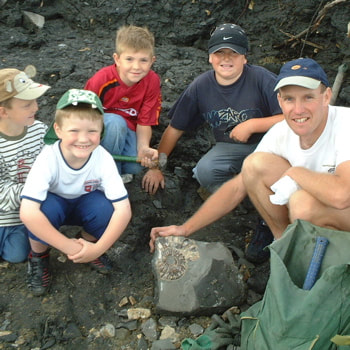
BRANDON DELIVERS EXPERT TUITION IN FOSSIL FINDING
News article from Thursday 23rd August 2007, Western Gazette UK
An article written by Lorna Jenkin (Community activist, writes for the Western Gazette each week.............)Almost every day, especially in summer, the beach between Lyme and Charmouth is busy with fossil hunters - some professional, but many amateurs enjoying the possibility of finding something exciting to take home. Last week I decided to discover fossiling as experienced by holidaymakers under the direction of an expert. Brandon Lennon, often with his geologist father Ian, leads a party on to either Monmouth beach or towards Charmouth. I joined a dozen eager holidaymakers by the Cobb Gate Anchor and Brandon led us to the mud slips towards Charmouth. On the way he gave advice on safe fossil collection to avoid the unstable cliffs, and soon we were picking up belemnites from a rocky area near the water's edge. Explaining that each tide washes the mud at the foot of the mudflows and releases new fossils, Brandon and Ian patiently described the stones which might conceal a fossil, while we learned to reject mud stones, flints and "beefsteak (Calcite)".
I came home, proudly bearing my belemnites - as did each and every member of the party - some fossil wood and many ammonites, which now have become a part of the rockery by the back door. On the beach that day there must have been more than 100 people bent searching for fossils, many of them led by guides or with an organised group or scientific study. Over the summer, that figure amounts to thousands of people, all gaining an insight into our fossil history, the scientific importance of Lyme and Charmouth, with some knowledge of the moving landslips, our geological links in Yorkshire and the greatest story of the Jurassic Coast.
There are several expert fossil guides taking walks daily along the coast from Lyme and Charmouth, but the timing varies according to the tides and the Tourist Information Centre, on 01297 442138, can give more information.The future of the annual Fossil Festival, the educational display and discovery walks led by Charmouth Hertiage Centre, Philpot Museum and fossil shop displays, and keen families just discovering for themselves all adds to the sum of knowledge of the international prestige and prominence of our local coast and of Lyme. However, noticing all the families, scrabbling and picnicking at the foot of the unstable cliff, I do wish more people would heed the warnings of the real risk of injury and death from cliff falls.The cliffs are very dangerous at Lyme Regis ,you must stay away from the dangerous cliffs .The best fossils are found at low tide washed from mudslips by the sea`s actions especially during storms.
News article from Thursday 23rd August 2007, Western Gazette UK
An article written by Lorna Jenkin (Community activist, writes for the Western Gazette each week.............)Almost every day, especially in summer, the beach between Lyme and Charmouth is busy with fossil hunters - some professional, but many amateurs enjoying the possibility of finding something exciting to take home. Last week I decided to discover fossiling as experienced by holidaymakers under the direction of an expert. Brandon Lennon, often with his geologist father Ian, leads a party on to either Monmouth beach or towards Charmouth. I joined a dozen eager holidaymakers by the Cobb Gate Anchor and Brandon led us to the mud slips towards Charmouth. On the way he gave advice on safe fossil collection to avoid the unstable cliffs, and soon we were picking up belemnites from a rocky area near the water's edge. Explaining that each tide washes the mud at the foot of the mudflows and releases new fossils, Brandon and Ian patiently described the stones which might conceal a fossil, while we learned to reject mud stones, flints and "beefsteak (Calcite)".
I came home, proudly bearing my belemnites - as did each and every member of the party - some fossil wood and many ammonites, which now have become a part of the rockery by the back door. On the beach that day there must have been more than 100 people bent searching for fossils, many of them led by guides or with an organised group or scientific study. Over the summer, that figure amounts to thousands of people, all gaining an insight into our fossil history, the scientific importance of Lyme and Charmouth, with some knowledge of the moving landslips, our geological links in Yorkshire and the greatest story of the Jurassic Coast.
There are several expert fossil guides taking walks daily along the coast from Lyme and Charmouth, but the timing varies according to the tides and the Tourist Information Centre, on 01297 442138, can give more information.The future of the annual Fossil Festival, the educational display and discovery walks led by Charmouth Hertiage Centre, Philpot Museum and fossil shop displays, and keen families just discovering for themselves all adds to the sum of knowledge of the international prestige and prominence of our local coast and of Lyme. However, noticing all the families, scrabbling and picnicking at the foot of the unstable cliff, I do wish more people would heed the warnings of the real risk of injury and death from cliff falls.The cliffs are very dangerous at Lyme Regis ,you must stay away from the dangerous cliffs .The best fossils are found at low tide washed from mudslips by the sea`s actions especially during storms.
Sunstones
In 2005, visitors to the western shores of Lyme Regis, in Dorset, have been seen standing spellbound on the beach staring at one of nature's geological 'sunstones.'
These large round rock nodules, often as large as one metre in diameter, have been washed from the 190 million year old Jurassic clays and dumped on the beach for us all to see. They have been christened 'sunstones' because, on their upper surfaces, they have fiery streaks of the mineral 'beef' calcite radiating out from their centres. Visitors have likened the effect to that of a Pagan drawing of a Sun or even a Van Gogh painting. Sadly, however, these natural wonders have been found to be of a transient nature. At Monmouth Beach and Seven Rock point what were once whole nodules have been found in pieces. For a while, Local fossil hunters were accused of attacking the nodules with their hammers. Brandon Lennon, one of the local fossil collectors decided to record the demise of the sunstones and so dispel the myth. With a series of photographs, taken during the course of the summer, he has shown that nature itself is the culprit. Released from their clay environment, the nodules are baked by the sun and then soaked by the sea with each successive tide. Soon they start to crack. It then only takes one storm to pull them to pieces and wear them away. Like the real sun, apparently rising from the sea in the morning and sinking below the horizon in the evening, they too return to the waves from whence they originally came.
Photos of the "sunstones". Dave and Sue were on a fossilwalk with us to Monmouth beach, whilst at Seven Rocks Point and they took these fantastic photos.
In 2005, visitors to the western shores of Lyme Regis, in Dorset, have been seen standing spellbound on the beach staring at one of nature's geological 'sunstones.'
These large round rock nodules, often as large as one metre in diameter, have been washed from the 190 million year old Jurassic clays and dumped on the beach for us all to see. They have been christened 'sunstones' because, on their upper surfaces, they have fiery streaks of the mineral 'beef' calcite radiating out from their centres. Visitors have likened the effect to that of a Pagan drawing of a Sun or even a Van Gogh painting. Sadly, however, these natural wonders have been found to be of a transient nature. At Monmouth Beach and Seven Rock point what were once whole nodules have been found in pieces. For a while, Local fossil hunters were accused of attacking the nodules with their hammers. Brandon Lennon, one of the local fossil collectors decided to record the demise of the sunstones and so dispel the myth. With a series of photographs, taken during the course of the summer, he has shown that nature itself is the culprit. Released from their clay environment, the nodules are baked by the sun and then soaked by the sea with each successive tide. Soon they start to crack. It then only takes one storm to pull them to pieces and wear them away. Like the real sun, apparently rising from the sea in the morning and sinking below the horizon in the evening, they too return to the waves from whence they originally came.
Photos of the "sunstones". Dave and Sue were on a fossilwalk with us to Monmouth beach, whilst at Seven Rocks Point and they took these fantastic photos.
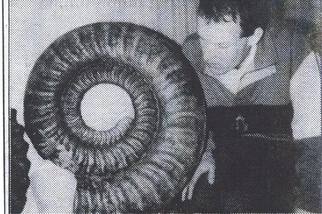
FOSSILISED GIANT
Beachcombing has netted a Cheddar businessman what he believes is the largest fossil Ammonite ever found in Britain.
Ian Lennon, proprietor of the family firm of Lennon's, which sells anything from diamonds to fossilised dinosaur dung in Union Street, Cheddar, made his discovery after rain had washed away clay on the cliffs at Lyme Regis.
It took four of them to haul out the giant object, which had laid hidden in the earth since it was fossilised 190 million years ago. The Ammonite is almost three feet long. "We are pretty sure it is one of the largest ever found" said Mr Lennon. The fossil has been acquired by Mr Martin Foster, of Lyme Regis, owner of the largest privately owned collection of Ammonites in Britain.
Beachcombing has netted a Cheddar businessman what he believes is the largest fossil Ammonite ever found in Britain.
Ian Lennon, proprietor of the family firm of Lennon's, which sells anything from diamonds to fossilised dinosaur dung in Union Street, Cheddar, made his discovery after rain had washed away clay on the cliffs at Lyme Regis.
It took four of them to haul out the giant object, which had laid hidden in the earth since it was fossilised 190 million years ago. The Ammonite is almost three feet long. "We are pretty sure it is one of the largest ever found" said Mr Lennon. The fossil has been acquired by Mr Martin Foster, of Lyme Regis, owner of the largest privately owned collection of Ammonites in Britain.
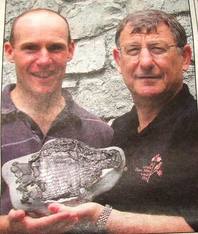
Fish fossils reunited after journey from Canada
(From Bridport and Lyme Regis News article, Friday, July 21st 2006)
A CHANCE conversation at a luncheon resulted in the reuniting of two parts of a 195 Million year old fossil fish.
The amazing Jigsaw came together in 2005 at the home of the famous author, the late John Fowles, who - with his wife, Sarah, was entertaining fossil hunters, among them Lyme paleontologists Brandon Lennon and David Sole.
It transpired that Brandon had led a fossil walk, on which a canadian geology student had found one section of the specimen, and David had discovered the other washed on the same area of beach a few days earlier. The segments fitted perfectly and were painstakingly cleaned and prepared over several months by Andy Cowap, of Charmouth, and David Costin, of Lyme Regis, before being presented to Greg Flude, of Toronto, father of student Lija.
Brandon, who has been leading fossil walks in the area for 20 years, said the late Mr Fowles and Sarah always took a great interest in the geology of the area. "It was a delight to have lunch with them," he said.
Many fossil collectors have been made welcome at their home. "All around the table were in awe about the fossil fish, with Sarah pondering the great coincidence of the parts coming together in such a way." The Larger portion of the fossil fish, a Dapedium from the Jurassic period, was found by Lija near Black Ven. While on the walk with Brandon, Lija (22), who is studying for a master's degree in palaeontology, also found part of the tibia of a scelidosaurus, a very rare herbivorous dinosaur on earth 200 million years ago. Only two nearly complete specimens of the creature, possibly an ancestor of the stegosaurus, have been found along with parts of six others.
These fossils have only ever been discovered between Lyme Regis and Charmouth and nowhere else in the world.Pictures below-The fossil fish found by Lija and David Sole.
(From Bridport and Lyme Regis News article, Friday, July 21st 2006)
A CHANCE conversation at a luncheon resulted in the reuniting of two parts of a 195 Million year old fossil fish.
The amazing Jigsaw came together in 2005 at the home of the famous author, the late John Fowles, who - with his wife, Sarah, was entertaining fossil hunters, among them Lyme paleontologists Brandon Lennon and David Sole.
It transpired that Brandon had led a fossil walk, on which a canadian geology student had found one section of the specimen, and David had discovered the other washed on the same area of beach a few days earlier. The segments fitted perfectly and were painstakingly cleaned and prepared over several months by Andy Cowap, of Charmouth, and David Costin, of Lyme Regis, before being presented to Greg Flude, of Toronto, father of student Lija.
Brandon, who has been leading fossil walks in the area for 20 years, said the late Mr Fowles and Sarah always took a great interest in the geology of the area. "It was a delight to have lunch with them," he said.
Many fossil collectors have been made welcome at their home. "All around the table were in awe about the fossil fish, with Sarah pondering the great coincidence of the parts coming together in such a way." The Larger portion of the fossil fish, a Dapedium from the Jurassic period, was found by Lija near Black Ven. While on the walk with Brandon, Lija (22), who is studying for a master's degree in palaeontology, also found part of the tibia of a scelidosaurus, a very rare herbivorous dinosaur on earth 200 million years ago. Only two nearly complete specimens of the creature, possibly an ancestor of the stegosaurus, have been found along with parts of six others.
These fossils have only ever been discovered between Lyme Regis and Charmouth and nowhere else in the world.Pictures below-The fossil fish found by Lija and David Sole.
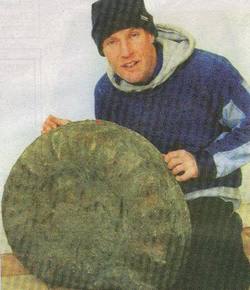
Monster fossil find
(From Bridport and Lyme Regis News article, Friday, 10th March 2006)
PROFESSIONAL fossil hunter Brandon Lennon got a monster surprise when he stumbled across a giant ammonite on the beach at Lyme Regis. The perfect specimen - a rare Arietites bucklandi - is one of the largest ever found along the Jurassic Coast.
And it was just sitting there on the pebbles - west of Monmouth Beach at Seven Rocks points - having been spewed out of a mudslide where it has been entombed for millions of years. Measuring around 2.5ft across, it weighs about 150lbs and transporting it across the shingle before it was destroyed by the incoming tide was a race against time.
Mr Lennon said: "I had to carry it off the beach tied to my metal-framed rucksack. The whole thing was quite extraordinary - to be just walking along and then find an ammonite that large just sitting on the beach. It was so lucky as the tide would have broken it to pieces - they are relatively fragile against the strength of the sea."
It is the second giant ammonite Mr Lennon has found in the same area. Three years ago he discovered an even bigger one which is now on show at Cardiff Museum.
His latest find will get its first public showing at the Lyme Regis Fossil Festival, which takes place between April 28 and 30. Mr Lennon will also be there to demonstrate the fossil preparation techniques that are used by professional collectors.
(From Bridport and Lyme Regis News article, Friday, 10th March 2006)
PROFESSIONAL fossil hunter Brandon Lennon got a monster surprise when he stumbled across a giant ammonite on the beach at Lyme Regis. The perfect specimen - a rare Arietites bucklandi - is one of the largest ever found along the Jurassic Coast.
And it was just sitting there on the pebbles - west of Monmouth Beach at Seven Rocks points - having been spewed out of a mudslide where it has been entombed for millions of years. Measuring around 2.5ft across, it weighs about 150lbs and transporting it across the shingle before it was destroyed by the incoming tide was a race against time.
Mr Lennon said: "I had to carry it off the beach tied to my metal-framed rucksack. The whole thing was quite extraordinary - to be just walking along and then find an ammonite that large just sitting on the beach. It was so lucky as the tide would have broken it to pieces - they are relatively fragile against the strength of the sea."
It is the second giant ammonite Mr Lennon has found in the same area. Three years ago he discovered an even bigger one which is now on show at Cardiff Museum.
His latest find will get its first public showing at the Lyme Regis Fossil Festival, which takes place between April 28 and 30. Mr Lennon will also be there to demonstrate the fossil preparation techniques that are used by professional collectors.
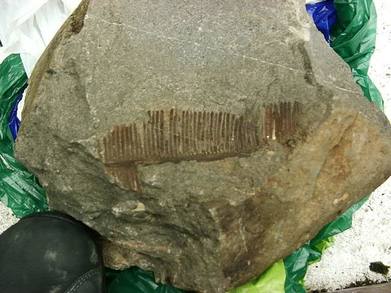
Fossil man's historic find
(From Bridport and Lyme Regis News article, Friday, July 22st 2005)
A fossil collector from lyme is set to go down in history with his unique and exciting find.
Brandon Lennon, who has been collecting for 20 years, found a fossil plant from the Jurassic rocks on the Isle of Skye in Scotland while he was visiting his parents. Mr Lennon recognised that the fossil was unique as it had retained its three dimensional structure. He sent a picture of his find to fossil plant expert Dr Jason Hilton at the University of Birmingham. Dr Hilton said: "We have looked at the specimen and can conclude that it is a species Bennettitalean seed fern pterophyllum.
The genus - or plant group - was well known through finds on Yorkshire's Jurassic coast, he added. "It was produced from an ancient fossil plant that is now extinct". "We can't determine the exact species until the specimen has been fully prepared, but it is highly likely to be a new species of the genus pterophyllum. Its a cracking specimen, that's for sure."
Mr Lennon said he was amazed that the fossil, which is more than 165 million years old, was in such good condition. He said: "As most of the Jurassic rocks in Britain are marine, it is not often that well preserved fossil plants are discovered, particularly wth delicate structures such as leaves. "think of a fern frond, for example, thrown into the sea. It would be tossed and turned by the waves and currents with little likelihood of being buried".
The plant found is anatomically preserved and retains its three dimensional structure. It is likely to provide a lot of new information on this kind of plant, as there is nothing like that from Britain that has been 'described'.
"As such this is a major discovery, and is likely to provide a lot of information on this kind of plant." Mr Lennon says that his find was by chance. " I keep getting congratulations, but anyone can get up and go and walk in the field to find curiosities. My joy will be showing it on my free fossil workshops on saturday mornings at 10am. These start this weekend (July 2005) at my workshop. After more talks at the weekend the final resting point for my great find will most likely be Edinburgh museum."
After the specimen has been on display for several weeks, scientists will work on it so it can be formally described.
(From Bridport and Lyme Regis News article, Friday, July 22st 2005)
A fossil collector from lyme is set to go down in history with his unique and exciting find.
Brandon Lennon, who has been collecting for 20 years, found a fossil plant from the Jurassic rocks on the Isle of Skye in Scotland while he was visiting his parents. Mr Lennon recognised that the fossil was unique as it had retained its three dimensional structure. He sent a picture of his find to fossil plant expert Dr Jason Hilton at the University of Birmingham. Dr Hilton said: "We have looked at the specimen and can conclude that it is a species Bennettitalean seed fern pterophyllum.
The genus - or plant group - was well known through finds on Yorkshire's Jurassic coast, he added. "It was produced from an ancient fossil plant that is now extinct". "We can't determine the exact species until the specimen has been fully prepared, but it is highly likely to be a new species of the genus pterophyllum. Its a cracking specimen, that's for sure."
Mr Lennon said he was amazed that the fossil, which is more than 165 million years old, was in such good condition. He said: "As most of the Jurassic rocks in Britain are marine, it is not often that well preserved fossil plants are discovered, particularly wth delicate structures such as leaves. "think of a fern frond, for example, thrown into the sea. It would be tossed and turned by the waves and currents with little likelihood of being buried".
The plant found is anatomically preserved and retains its three dimensional structure. It is likely to provide a lot of new information on this kind of plant, as there is nothing like that from Britain that has been 'described'.
"As such this is a major discovery, and is likely to provide a lot of information on this kind of plant." Mr Lennon says that his find was by chance. " I keep getting congratulations, but anyone can get up and go and walk in the field to find curiosities. My joy will be showing it on my free fossil workshops on saturday mornings at 10am. These start this weekend (July 2005) at my workshop. After more talks at the weekend the final resting point for my great find will most likely be Edinburgh museum."
After the specimen has been on display for several weeks, scientists will work on it so it can be formally described.
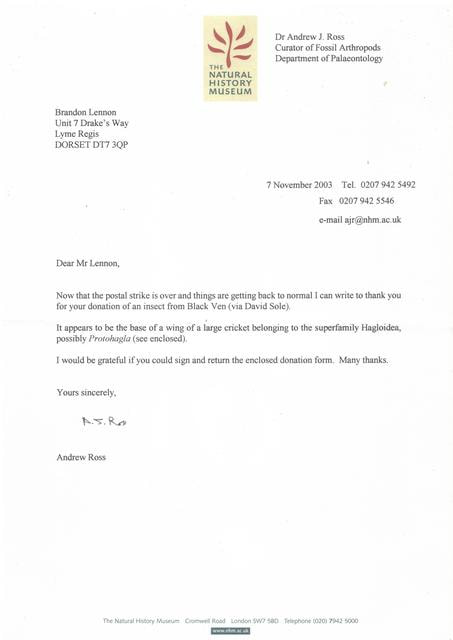
Certain fossils are to be recorded at the Charmouth Heritage Centre.The fossil insect I found at Black Ven ,Lyme Regis was registered as a key scientifically important specimen.It looked small and insignificant,but it ended up going to the Natural History Museum.Many of the fossils in Lyme Bay end up quickly being destroyed by the sea`s highly destructive power!
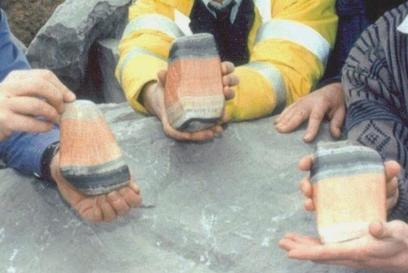
Brandon's gem of a find from 200 million year old quake - Prehistoric stone polishes up a treat
GEMOLOGIST HAS STUNNING NEW MEDIUM TO WORK IN AFTER GREAT QUARRY BLAST
(Article from Bridport and Lyme Regis News, March 20th, 1998)
Local gemnologist Brandon Lennon has found a stunning new medium to work - stone formed in an earthquake 200 Million years ago and discovered during routine blasting in a quarry.
With it, Brandon, who lives and works at Rocombe, near Lyme Regis, has created a Henry Moore style sculpture which is turning heads at an art exhibition. And, to show his apprieciation, he has presented the ARC Quarrying Company with three beautifully polished stones which have pride of place in the company's head office in Chipping Sodbury. A huge boulder from the rock, which before the earthquake lined the floor and ceiling of an ancient cave, is fascinating visitors to the Earth Galleries at the Natural History Museum in London. When the earthquake hit, the ceiling shattered into fragments which is clearly visible in the reformed rock.
Brandon first learned about the stone when he was asked to polish a small piece for Neville Hollingworth, who was involved in the project for the museum."The stone was so beautiful after polishing, I asked Neville, whether he could obtain a larger piece of rock," said Brandon. "ARC manager Richard Webb was happy to oblige, and it was from this I made the statue."
"The stone is barite, which is a soft material, but very heavy and dense. It is quite difficult to work in, and the deep salmon colour is only revealed after lots of debris has been ground away.
GEMOLOGIST HAS STUNNING NEW MEDIUM TO WORK IN AFTER GREAT QUARRY BLAST
(Article from Bridport and Lyme Regis News, March 20th, 1998)
Local gemnologist Brandon Lennon has found a stunning new medium to work - stone formed in an earthquake 200 Million years ago and discovered during routine blasting in a quarry.
With it, Brandon, who lives and works at Rocombe, near Lyme Regis, has created a Henry Moore style sculpture which is turning heads at an art exhibition. And, to show his apprieciation, he has presented the ARC Quarrying Company with three beautifully polished stones which have pride of place in the company's head office in Chipping Sodbury. A huge boulder from the rock, which before the earthquake lined the floor and ceiling of an ancient cave, is fascinating visitors to the Earth Galleries at the Natural History Museum in London. When the earthquake hit, the ceiling shattered into fragments which is clearly visible in the reformed rock.
Brandon first learned about the stone when he was asked to polish a small piece for Neville Hollingworth, who was involved in the project for the museum."The stone was so beautiful after polishing, I asked Neville, whether he could obtain a larger piece of rock," said Brandon. "ARC manager Richard Webb was happy to oblige, and it was from this I made the statue."
"The stone is barite, which is a soft material, but very heavy and dense. It is quite difficult to work in, and the deep salmon colour is only revealed after lots of debris has been ground away.
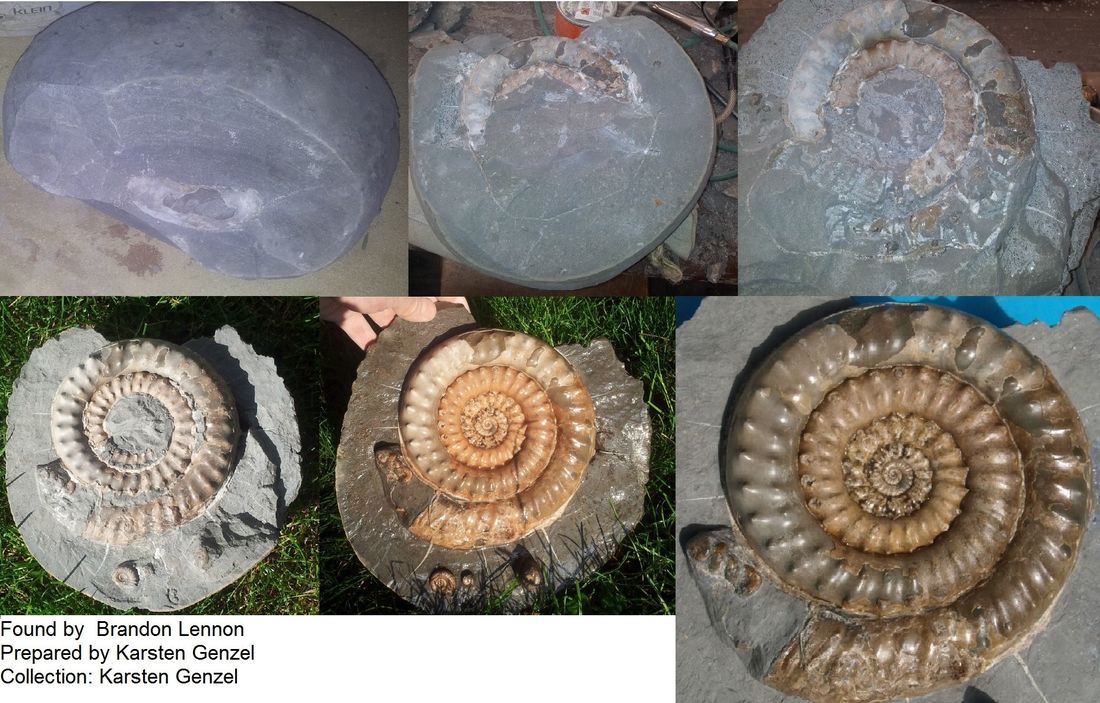
The Lure of Fossils for hunter Brandon
(Article from Pulman's Weekly News and Advertiser, March 8th, 2006)
The recent collapse of part of the cliff at Stonebarrow, with the resultant massive mud slide descending on to Charmouth Beach, was immediately the focus and attention for fossil seekers, eager to discover just what the erosion had disclosed.
Amongst the fossil hunters was, of course, Brandon Lennon, the local Lyme Regis professional collector who, with 20 years experience behind him, is now recognised as a leading expert in the field. Not only does Brandon hunt for fossils for retail via Mike's Minerals and Fossils, 7 Drake's way in Lyme Regis, but he also conducts guided tours along selected parts of Lyme Bays Jurassic coast giving direct tuition to beginners and novice fossil enthusiasts.
How, I asked Brandon, did it all begin? "Well, I've been collecting seriously since I was 16, but before that I was hunting for fossils as a child, and of course, as an amateur. Initially I came over from Australia and when I was a youngster in that country, my dad was an exploration geologist and he also did a great deal of gold panning, so I suppose I grew up with a love of natural wonders, fossils were a natural progression".
The lure, that attraction of fossils, must be, of course, their immense age and the simple fact that one can handle and see the remains or the signature of a creature which lived scores or hundreds of million years ago, a time which is totally beyond our comprehension. We think, where man's history is concerned, in terms of hundreds and thousands of years, but our own recorded two millennia of history is a mere flick of time's eyelid when compared to the first abundant fossil remains of creatures which lived 570 Million years ago during the Cambrian period.
As Brandon puts it: "I just love the fact that there on the beach you can open a rock to disclose a perfectly preserved fossil which hasn't been seen for millions of years, but which is there, in front of your eyes".Brandon told me that he has kept, for his personal collection, a few of the really choice specimens he found over the years and which he will be exhibiting at the Lyme Regis Fossil Festival this spring (2006), so there will be a chance for people to see fossils which have never been seen before which he prepared and which is some of the best material from this area.
Following the recent Stonebarrow cliff collapse, Brandon discovered a vast ammonite, nearly three feet in diameter and which now resides in his kitchen for safe keeping. The immense creature was, he said, an Arietites ammonite and in the region of 190 Million years old. Not unnaturally, the early collector, like the early bird, gathers the goodies and, following the cliff slide, collectors were there at first light to see what had been eroded off the toe of the slip by incoming waves.
Other fossils which Brandon has been fortunate to discover included part of the Plesiosaurus, that same creature which has been offered by Nessie hunters as a model for the Loch Ness monster, and Ichthyosaurus vertebrae and entire skulls, and odd specimens which, when fitted together with parts other fossil hunters have, recreated the entire creature.
Although Brandon spends most of his time in the Lyme Bay area, one of his favourite hunting regions is the Isle of Skye. Here he has found some really excellent specimens and, once again, in the same type of sedimentary rocks as those found here, in Dorset. Last year he discovered a hitherto unknown plant fossil which will be named after him and which is currently being described by a scientific investigator. Here on the Jurassic Coast, Brandon's favourite hunting areas are the regular spots, beloved of all collectors, namely Black Ven, and Stonebarrow, both which are visited by numerous collectors.
He made the point that part of his living is made from selling fossils...."but you don't just walk out there to find perfect specimens. You have to prepare and produce them from the rock, then make them aesthetically pleasing using preservation techniques."
Now, if you'd like to discover more about fossils and the techniques used for collecting them, a guided walk with Brandon is the obvious solution.Our walks take place in the holiday periods.The location where each walk takes place is of course, dictated by the state of the tide, and to some extent by the weather.The fossil collecting trips are three to four hours long .The fossil collecting tours can be booked privately along the Jurassic Coast.As fossil collecting guides we will be aware of the current beach conditions for your walk.For fossil collecting you need perseverance,persistance,patience and passion.The thrill of seeking fossils is exciting ,to find your own beautiful specimen by yourself can be exhilerating.On a lucky day when you find a fossil you will have a memory of that special day in the fossil that you found!
(Article from Pulman's Weekly News and Advertiser, March 8th, 2006)
The recent collapse of part of the cliff at Stonebarrow, with the resultant massive mud slide descending on to Charmouth Beach, was immediately the focus and attention for fossil seekers, eager to discover just what the erosion had disclosed.
Amongst the fossil hunters was, of course, Brandon Lennon, the local Lyme Regis professional collector who, with 20 years experience behind him, is now recognised as a leading expert in the field. Not only does Brandon hunt for fossils for retail via Mike's Minerals and Fossils, 7 Drake's way in Lyme Regis, but he also conducts guided tours along selected parts of Lyme Bays Jurassic coast giving direct tuition to beginners and novice fossil enthusiasts.
How, I asked Brandon, did it all begin? "Well, I've been collecting seriously since I was 16, but before that I was hunting for fossils as a child, and of course, as an amateur. Initially I came over from Australia and when I was a youngster in that country, my dad was an exploration geologist and he also did a great deal of gold panning, so I suppose I grew up with a love of natural wonders, fossils were a natural progression".
The lure, that attraction of fossils, must be, of course, their immense age and the simple fact that one can handle and see the remains or the signature of a creature which lived scores or hundreds of million years ago, a time which is totally beyond our comprehension. We think, where man's history is concerned, in terms of hundreds and thousands of years, but our own recorded two millennia of history is a mere flick of time's eyelid when compared to the first abundant fossil remains of creatures which lived 570 Million years ago during the Cambrian period.
As Brandon puts it: "I just love the fact that there on the beach you can open a rock to disclose a perfectly preserved fossil which hasn't been seen for millions of years, but which is there, in front of your eyes".Brandon told me that he has kept, for his personal collection, a few of the really choice specimens he found over the years and which he will be exhibiting at the Lyme Regis Fossil Festival this spring (2006), so there will be a chance for people to see fossils which have never been seen before which he prepared and which is some of the best material from this area.
Following the recent Stonebarrow cliff collapse, Brandon discovered a vast ammonite, nearly three feet in diameter and which now resides in his kitchen for safe keeping. The immense creature was, he said, an Arietites ammonite and in the region of 190 Million years old. Not unnaturally, the early collector, like the early bird, gathers the goodies and, following the cliff slide, collectors were there at first light to see what had been eroded off the toe of the slip by incoming waves.
Other fossils which Brandon has been fortunate to discover included part of the Plesiosaurus, that same creature which has been offered by Nessie hunters as a model for the Loch Ness monster, and Ichthyosaurus vertebrae and entire skulls, and odd specimens which, when fitted together with parts other fossil hunters have, recreated the entire creature.
Although Brandon spends most of his time in the Lyme Bay area, one of his favourite hunting regions is the Isle of Skye. Here he has found some really excellent specimens and, once again, in the same type of sedimentary rocks as those found here, in Dorset. Last year he discovered a hitherto unknown plant fossil which will be named after him and which is currently being described by a scientific investigator. Here on the Jurassic Coast, Brandon's favourite hunting areas are the regular spots, beloved of all collectors, namely Black Ven, and Stonebarrow, both which are visited by numerous collectors.
He made the point that part of his living is made from selling fossils...."but you don't just walk out there to find perfect specimens. You have to prepare and produce them from the rock, then make them aesthetically pleasing using preservation techniques."
Now, if you'd like to discover more about fossils and the techniques used for collecting them, a guided walk with Brandon is the obvious solution.Our walks take place in the holiday periods.The location where each walk takes place is of course, dictated by the state of the tide, and to some extent by the weather.The fossil collecting trips are three to four hours long .The fossil collecting tours can be booked privately along the Jurassic Coast.As fossil collecting guides we will be aware of the current beach conditions for your walk.For fossil collecting you need perseverance,persistance,patience and passion.The thrill of seeking fossils is exciting ,to find your own beautiful specimen by yourself can be exhilerating.On a lucky day when you find a fossil you will have a memory of that special day in the fossil that you found!
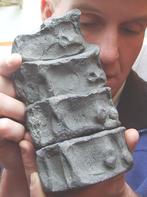
The Ichthyosaur back bones you see in the photo are from Black Ven ,Lyme Regsis,Dorset.Merrilynne Lennon found them on a landslide ,which used to have an old oak tree on the top.My Mum recognized the smallest piece of bone that was sticking out of the sand on the beach.The vertebrae must have been from a big specimen of Ichthyosaur ,which are rare to find articulated.

